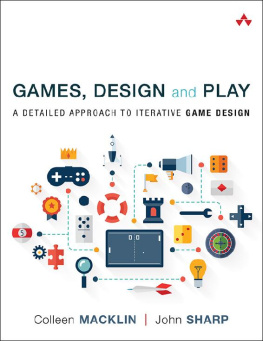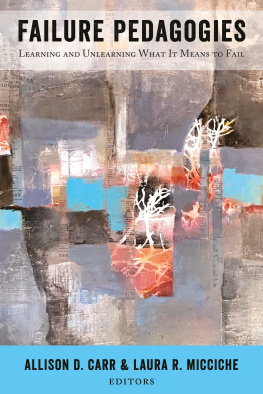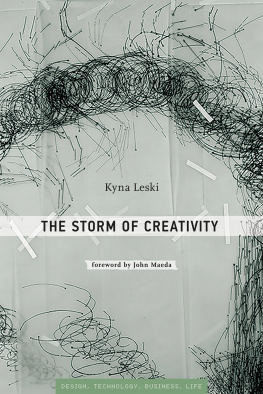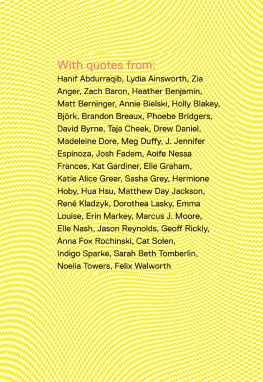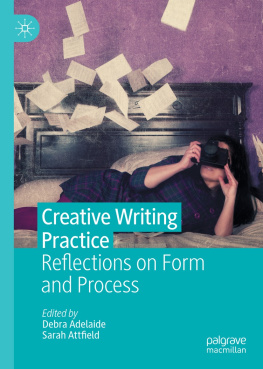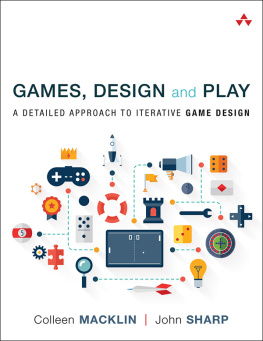Iterate
Ten Lessons in Design and Failure
John Sharp and Colleen Macklin
illustrations by Steven Davis with Yu Jen Chen
diagrams by Tuba Ozkan and Carla Molins Pitarch
The MIT Press
Cambridge, Massachusetts
London, England
2019 Massachusetts Institute of Technology
All rights reserved. No part of this book may be reproduced in any form by any electronic or mechanical means (including photocopying, recording, or information storage and retrieval) without permission in writing from the publisher.
This book was set in ITC Stone Sans Std and ITC Stone Serif Std by Toppan Best-set Premedia Limited. Printed and bound in the United States of America.
Library of Congress Cataloging-in-Publication Data
Names: Sharp, John, 1967- author. | Macklin, Colleen, author.
Title: Iterate : ten lessons in design and failure / John Sharp and Colleen Macklin ;
illustrated by Steven Davis and Yu Jen Chen ; drawings by Tuba
Ozkan and Carla Molins Pitarch.
Description: Cambridge, MA : The MIT Press, 2019. | Includes bibliographical
references and index.
Identifiers: LCCN 2018028590 | ISBN 9780262039635 (hardcover : alk. paper)
eISBN 9780262352116
Subjects: LCSH: DesignPsychological aspects. | DesignTechnique. | Failure
(Psychology)
Classification: LCC NK1520 .S47 2019 | DDC 745.4dc23 LC record available at https://lccn.loc.gov/2018028590
ePub Version 1.0
Table of Contents
List of figures
- Chapter 5
- Chapter 6
- Chapter 8
- Chapter 9
- Chapter 10
- Chapter 11
- Chapter 12
- Chapter 13
- Chapter 14
Guide
Acknowledgments
This project couldnt have happened without a bewilderingly large group of people. For starters, we must thank the subjects of our case studies in the book and in our video series: Jad Abumrad and Robert Krulwich, Amelia Brodka, Wylie Dufresne, Cas Holman, Miranda July, Alexis Lloyd, Matthew Maloney, Andy Milne, Nathalie Pozzi and Eric Zimmerman, Allison Tauziet, and Baratunde Thurston. Well be a little cheesy and admit weve been inspired by all of you.
Over the last five years, we had the pleasure of working with a group of research assistants from the MFA Design and Technology program at Parsons School of Design at The New School. Gabrielle Patacsil served as producer for the initial case study interviews and the related video series. Shuangshuang Huo shot and edited most of the videos, with the remainder shot and edited by Kabeer. Angelica Jang created the imagery and animations used on the website and in the videos. Miyeon Kim created animations for one of our videos, and helped us brainstorm approaches to the diagrams and illustrations for the book. Aakanksha Aggarwal, Ryan Best, Yu Jen Chen, Connie Chu, Clare Churchouse, Mario Dcunha, Barsha Maharjan, Jim Pinkenberg, Carla Molins Pitarch, Aucher Serr, Yanbin Song, and Nicolas Stark participated in a diagram jam to help us think through visualizing creative practice. Steven Davis created the illustrations with the input of Yu Jen Chen, while Tuba Ozkan and Carla Molins Pitarch developed and produced the diagrams included in the book.
The involvement of these great people, as well as travel funding, came courtesy of support from The New School Provosts Office Faculty Research Fund; the Parsons Dean of Faculty Research Assistant program; and the Parsons School of Art, Media, and Technology Research, Scholarship and Creative Practice Fund.
Of course there are all the people that helped turn our ideas and research into this book: Doug Sery, who ushered us through the process of becoming MIT Press authors; Noah J. Springer, who kept us on track throughout the writing process; and Matthew Abbate and Paula Woolley, whose careful attention during the editing process cleaned our manuscript up quite nicely.
Last, but never least, we must thank Renee and Nancy, our respective partners in crime, fun, and love.
Colleen and John
Brooklyn, Spring 2018
Preface
If youve ever played a game, it is likely that youve experienced failure. Lots of it. Thats how games workwe fail our way toward understanding through play. At some point, likely after a few failed attempts, we learn that the shiny red stuff is lava, those mushroom creatures should be jumped over (or on), and the upper pinball flippers are indeed useful in avoiding the dreaded central gutter. Games are an alternate universe where failure is simply part of the fun.
In our capacity as game designers, weColleen and John, the authors of this bookthink about failure a lot, in no small part because game design is often about making failure fun. Perhaps because this failure inversion involves a kind of alchemy, game design is hard, and filled with all sorts of failures itself: crises of creativity, false starts in finding a path to fun, tensions between design goals and player expectations. Our main tool for working with all this failure? Iteration, or the cyclical process of conceptualizing, prototyping, playtesting, and evaluating a games design.
As you might have already guessed from the title of this book, were big fans of iteration.
Though we are currently both game designers, our creative practices have been diverse. Over the years, one or both of us have also worked in graphic design, web design and development, photography, DJing, VJing, advertising, and printmaking. Throughout it all, weve been fortunate to learn from each of the communities of practice weve worked within. And in our own work and in others, we have seen again and again how the cyclical nature of iteration is used to make sense of, learn from, and overcome the inevitable presence of failure.
We are also educators. Collectively, weve taught for over 40 years in university art and design programs (currently we both teach at Parsons School of Design in New York City). As we teach, there are two ever-present challenges we face: assisting students in the development of an effective creative process, and helping students learn to accept failure as an inevitable, even welcome aspect of creative practice. Really, these are one and the samefailure is ever-present in creative practice, so any useful approach to making things has to account for failure. We help our students learn how to conceptualize the things they want to create; how to develop and employ craft skills to give form to their ideas; how to use research to expand and bring rigor to their ideas; how to receive (and give) constructive criticism on their work and process; and finally, how to understand themselves and others better through everything they see, feel, and learn as they work.
In other words: We teach creativity.
In looking at the broad domain of creativity, we draw as much on our experiences as art school professors as on our own creative practice and the practices of our friends and colleagues. Over the years, weve collected practice-based examples from the arts, design, science, and any other field that we could use in our classrooms and in our own work. It was a short step from there to decide we wanted to share what weve learned with others. And thus this book, and our accompanying video series, found at http://www.iterateproject.com.
A Focus on Failure
Looking through research journals like Design Studies and Creativity Research Journal, we can find innumerable approaches to understanding creativity. Some are qualitative in nature, others quantitative. Many bring to bear scientific methods that strive to capture the essence of something ineffablecreativity. Shifting over to popular media, we can find an endless supply of breathless examples of how a practitioner created a particular work of art, wrote a critically lauded musical, or disrupted an entire industry. Invariably, these stories boil down to humble-brag variations on my muse showed me the way, or my genius flowed out of me (shrug emoji). Ultimately all of these approaches end up making creativity feel out of reach to mere mortals like ourselves. Most of these discussions of creativity, particularly in the fields of design and engineering, focus on two goals: problem solving and innovation. Both are closely associated with invention and the commercial instrumentalization of creativity. In creative practice, both lead to particular intentions and desires, and often boil down to institutionalized processes that leave little space for other motivations and outcomes. And ultimately, they privilege success over anything else.
Next page

